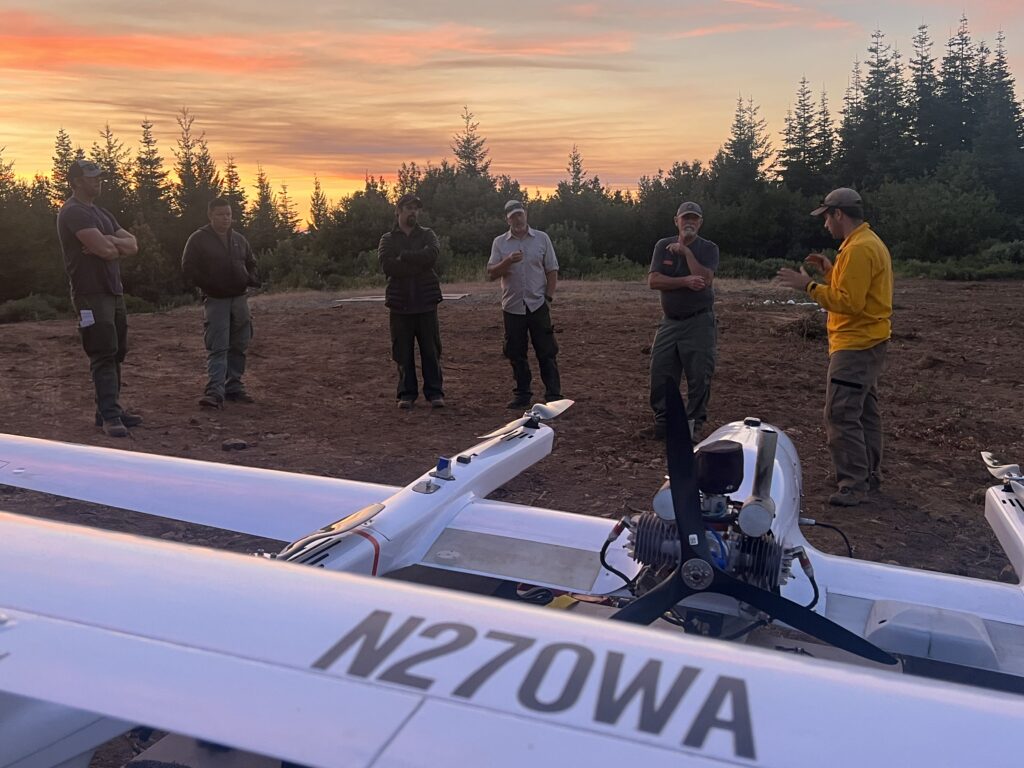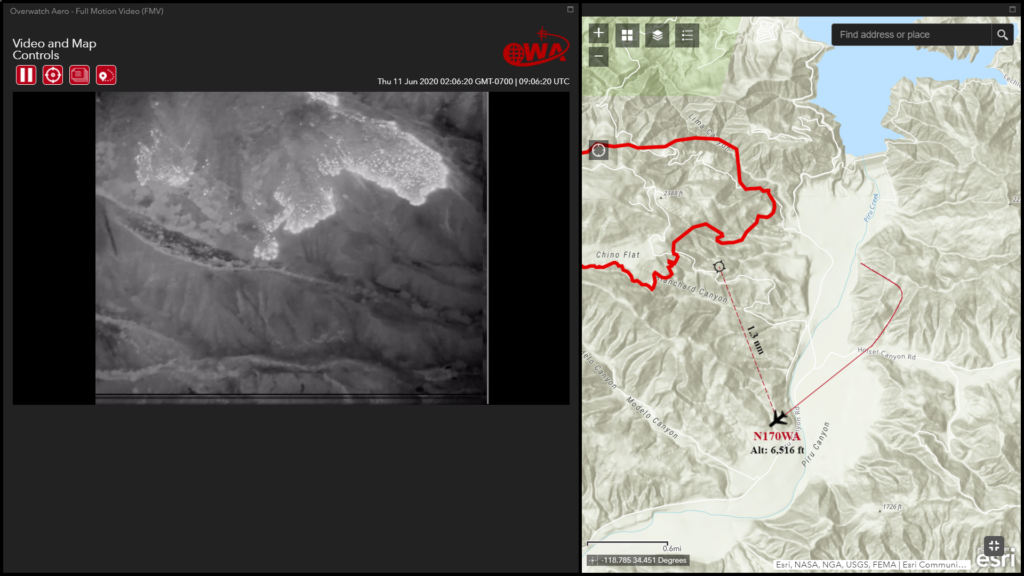By Dan Reese and Jordan Hahn
Wildfires pose a significant threat to ecosystems, wildlife, and human lives. As the frequency and intensity of wildfires continue to rise, finding innovative and efficient methods for surveillance and early detection is crucial. Unmanned Aerial Systems (UAS), commonly known as drones, have emerged as a powerful tool for wildfire surveillance. While many agencies are using small UASs for line-of-sight low-level operations, this article advocates for the widespread adoption of Type 1 UAS technology to enhance wildfire monitoring and response efforts while addressing the challenges associated with their implementation. In contrast to the battery-powered Type 3 UAS, typically weighing less than 55 pounds and with a flight time of an hour or less, Type 1 UAS are usually dual-powered, enabling them to operate for extended periods (8+ hours), carry heavier payloads, and reach higher altitudes. They are more akin to aircraft than traditional drones in wildland firefighting environments.
Advantages of Unmanned Aerial Systems:
- Cost-Effective Surveillance: Traditional methods of wildfire surveillance, such as manned aircraft or satellite imagery, can be expensive. UAS offers a cost-effective alternative, allowing for frequent and targeted monitoring without the high operational costs associated with traditional methods.
- Multiple Payloads: UASs can be equipped with many payloads, from EO/IR cameras to cells on wings. This allows for rapidly deploying advanced capabilities to wildfires. It is only a matter of time before UAS technology will progress to large payloads being made available for cargo and suppression missions. This has already been demonstrated through flight testing by the Kaman Aerospace Corporation of its new unmanned helicopter, the K-MAX TITAN™
- Real-time Data Collection: UAS equipped with high-resolution cameras and sensors provide real-time data on fire location, size, and progression disseminated directly to Incident Commanders and operations staff. This data is invaluable for making informed decisions and strategizing firefighting efforts efficiently.
- Enhanced Situational Awareness: UAS technology enhances situational awareness for firefighting teams by providing detailed aerial views of the wildfire area. This allows for a better understanding of the terrain, fire behavior, and potential risks, aiding in developing effective response plans.
- Reduced Risk to Human Lives: Wildfire-prone areas often present challenging and dangerous conditions for human surveillance. By employing UAS, we can significantly reduce the risk to human lives by avoiding the need for ground crews to navigate hazardous terrain. Additionally, by eliminating the need for human pilots to fly over dangerous terrain, UAS minimizes the potential for pilot-related accidents and enhances the efficiency of firefighting efforts.
- Nighttime Operations: Many wildfires burn at night, challenging persistent surveillance. UAS with infrared cameras enables nighttime operations, ensuring continuous monitoring and response capabilities. They can fly during nighttime, when most conventional aircraft are grounded due to safety concerns, filling a critical gap in coverage and providing essential intelligence during these otherwise inaccessible times.
- IFR Flight Conditions: The UAS flight equipment, payloads, and sensors allow flight operations to continue with the same benefits as night-time operations.
- Scalability: UAS can cover large areas and scale their operations based on the size and complexity of the wildfire. Multiple drones can collaborate to provide comprehensive coverage, making them suitable for small and large-scale wildfire incidents.

Challenges:
While UAS offers numerous advantages, challenges such as regulatory hurdles and adverse weather conditions must be addressed. Collaborative efforts between regulatory bodies, technology developers, and firefighting agencies can help overcome these challenges by implementing standardized protocols, advanced battery technology, and weather-resistant drone designs.
Although the 2023 Congressional Wildfire Commission Recommendations advocate for increased use and scaling of the UAS program, significant hurdles remain. The most considerable obstacles are inclusive of the following:
- Contracting: Type 1 use remains strictly Call When Needed and minimally used. It will remain stagnant until agencies fully embrace the development of UAS technology where Exclusive Use contracts are implemented.
- Funding: If Federal and State agencies are going to engage the full potential of the UAS successfully, these agencies will need to be funded appropriately. Contracting aside, this funding must include the staffing, training, and oversite that does not exist and is not currently being budgeted for. If program managers don’t have the personnel to support UAS use, their development and potential will not be realized.
- Reliability: The intermittent use of Unmanned Aerial Systems (UAS) introduces reliability challenges, as their sporadic operation limits consistent performance monitoring and problem detection due to minimal flight hours. This issue underscores the importance of a proactive approach, necessitating regular system checks and diagnostic assessments during operational downtime to identify and address potential problems. Government agencies can play a pivotal role in overcoming these challenges by strategically investing in UAS research and development and fostering advancements in diagnostic technologies and maintenance routines. Such investments enhance the reliability of UAS but also contribute to the development of resilient designs, ensuring their readiness for diverse applications in both public and private sectors.
- Increased costs: The costs associated with blue technology, a term that describes United States (US) manufactured products, must be accepted and realized by the federal agencies dictating the policy. The contracting prices will be reflected until these policies are changed or the United States develops reasonable, cost-effective solutions.
- Utilization: The agencies and Incident Management Teams (IMT) responsible for incidents must better embrace UAS utilization to realize sound policies and capabilities. IMTs should be educated on the unique capabilities and limitations of Type 1 UAS and encouraged to integrate them into existing operations and planning workflows.

Conclusion:
Utilizing Type 1 UAS for wildfire surveillance represents a transformative step in modernizing our approach to wildfire management. The cost-effectiveness, rapid deployment, and real-time data collection capabilities make UAS an indispensable tool in the fight against wildfires. As technology advances and regulatory frameworks evolve, embracing UAS for wildfire surveillance is not just an option but a necessity for building resilient and effective wildfire response strategies. Integrating UAS into our firefighting arsenal is a proactive and forward-thinking approach that can ultimately save lives, protect ecosystems, and mitigate the devastating impact of wildfires on communities.


